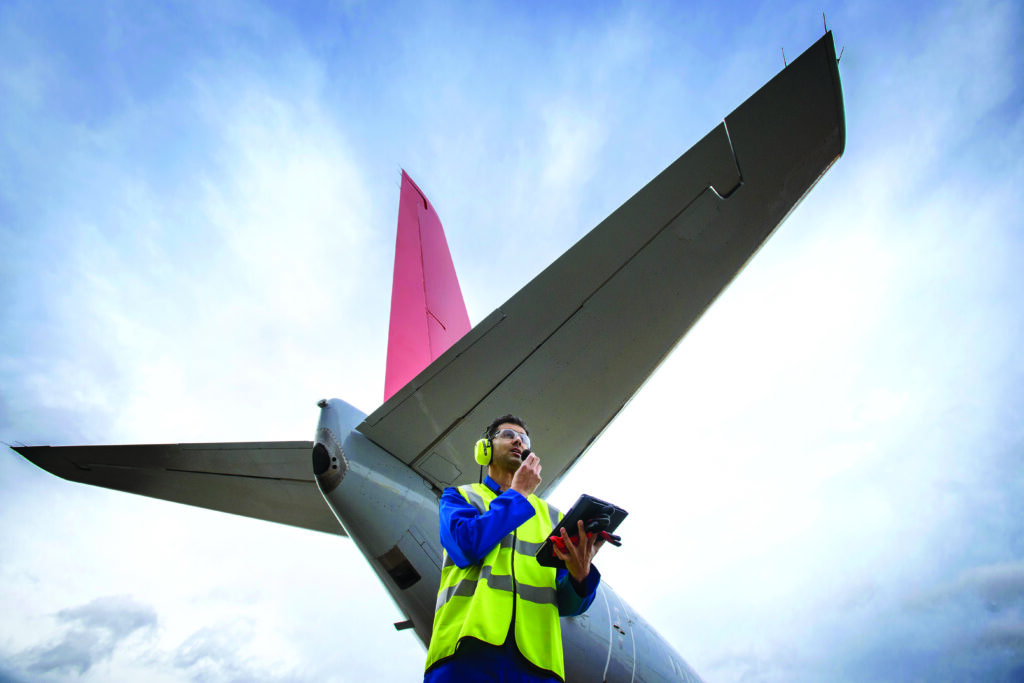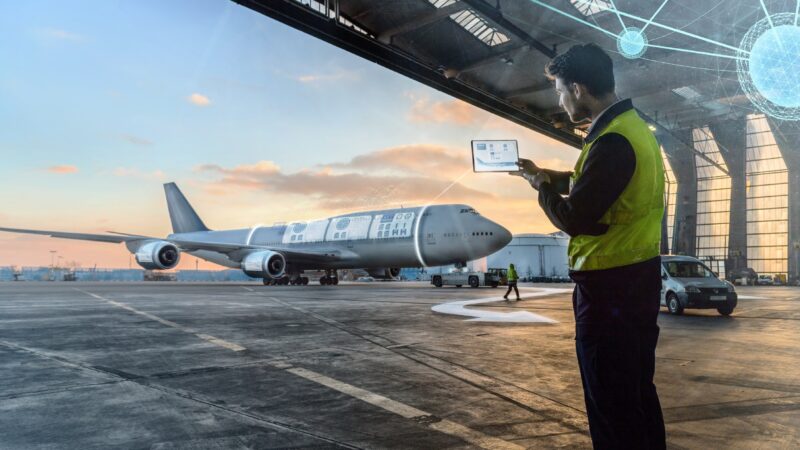As airlines seek to grow and prosper post-pandemic, predictive maintenance solutions and all that they promise are more appealing than ever before, as Emma Kelly reports
Predictive maintenance solutions are increasingly being taken up by airlines as they seek cost and time savings, particularly in the post-pandemic recovery period.
Ongoing developments in machine learning and artificial intelligence are making more sense of the wealth of data that comes off a modern airliner. The commercial aviation industry is recognising, however, that in order to truly unlock the predictive maintenance potential, more collaboration and data sharing is needed for the benefit of all.
Lufthansa Technik was a pioneer in predictive maintenance, developing solutions more than seven years ago as soon as the necessary computing power became available, says Mia Witzig (pictured below), head of digital fleet solutions. “We are building on the know-how of our operational engineers, supply chain and MRO experts who used statistical data for many decades to provide spare parts, maintenance and engineering services to airlines.”
The company’s ‘AVIATAR’ digital platform combines fleet management solutions, data science and engineering expertise to provide a comprehensive range of integrated digital services for airlines, MRO companies, OEMs and lessors. “When we launched AVIATAR in 2017, it was the only platform available and we enjoyed the first-to-market advantage. Initially, some airlines hesitated to embrace the new technology, but we are seeing strong growing market demand now, as the financial benefits become more and more obvious,” Witzig says.
Today, more than 3,400 aircraft from 50‑plus operators are connected to AVIATAR, with the majority using ‘Predictive Health Analytics’ (PHA). PHA makes sense of the wealth of operational data coming from modern aircraft, with data analysed in real-time and enriched with MRO shop reports and climatic/environmental data, for example. “Our PHA solution’s unique algorithms create tasks and visualise them in a very user-friendly design, which enables operators to minimise unscheduled maintenance,” explains Witzig.

Collins Aerospace is also seeing increasing demand for its predictive maintenance platform, ‘Ascentia’. Some 60 airlines around the world, operating approximately 2,500 aircraft, are using it, according to Brian McHugh, product owner, Ascentia, Connected Aviation Solutions. The Ascentia all-in-one solution provides health monitoring and predictive maintenance analytics. Customers can select an off-the-shelf product, whereby Collins provides the analytics, or they can develop their own analytics using a custom alerts feature, McHugh explains. Analytics are currently available for the A320, 737 NG, Boeing 787 and Embraer 170/190, with plans to expand the catalogue in 2023 with key reliability drivers for the 737 MAX, 777, A330, A350 and A220, he adds.
Ascentia has a competitive edge in a number of areas, McHugh believes, pointing to the systems expertise of Collins engineers on components even when Collins is not the OEM. “Our nose-to-tail approach means that airlines can view all their reliability information on a single platform,” he says. Furthermore, Collins has a 24/7 monitoring team that reviews each alert, ensuring “accurate, reliable and targeted” predictions. McHugh says the team can also help smaller airlines that want cutting-edge analytics without investing in a dedicated predictive maintenance team.
Another benefit is its custom alerts, with Collins recognising that airlines often have a support structure of expert mechanics and engineers that understand the technical aspects, but lack expert data scientists to translate insights into code. “Ascentia can provide a low code/no code environment where creating a complex predictive analytic is as simple as writing an Excel formula,” he says. “We believe that each airline owns their own data and we want our users to have unrestricted access to it. Rather than stand in an airline’s way, we want to enable users to do more with predictive maintenance.”
As a result, there has been strong interest from airlines, keen to benefit from its prognostics and health management (PHM) to improve operations. McHugh points, for example, to a retroactive case study for the flow control valve from an A320 operator when Collins applied Ascentia analytics to historical flight data. If the airline had been an Ascentia customer at the time, an Ascentia alert would have highlighted a valve issue months before the first MEL, allowing the airline to schedule targeted and proactive troubleshooting and part replacement in advance of the failure.
Without Ascentia, the airline engaged in multiple, ineffective troubleshooting efforts, says McHugh. Ascentia’s targeted analytics would have turned an unscheduled event into a scheduled one, reducing overtime, AOG shipping fees and increasing aircraft availability.
Aviation maintenance software from IFS is a core part of Rolls-Royce’s ‘Blue Data Thread’ initiative, which supports predictive maintenance for every life-limited component in Rolls-Royce Trent engines throughout their lifecycle. Using AI, the IFS aviation maintenance solution enables the automated provision of field data to ensure the engine manufacturer receives timely and accurate information on its Trent 1000, XWB and 7000 engines, says Rob Mather, vice president of aerospace and defense industries at IFS.
“IFS aviation maintenance software then acts as a gateway to automatically push maintenance programme changes from Rolls-Royce back to the airline operators. As a result, life-limited engine part maintenance deadlines are updated based on actual operating conditions and life consumed by each engine in use,” Mather explains.
The solution uses a multivariable predictive maintenance forecasting algorithm, based on an amalgamation of data from Rolls-Royce and the airline, to provide the most accurate information. “This is a perfect example of how, using this multitude of data points, value can be added to a collaborative predictive maintenance strategy,” he says. Mather adds that IFS is looking for additional predictive maintenance opportunities with other industry players.
Functionality of predictive maintenance solutions is increasing. The scope of Collins’ Ascentia, for example, has expanded and will continue. “Our approach is to be agnostic and provide solutions nose-to-tail,” says McHugh.
“We are always looking to push out features that will provide the greatest benefits to our customers by focusing on what they need and those we wished other tools had, and by leveraging over 20 years of experience specialising in PHM, reliability and engineering.”

Ascentia’s development is focused on features that drive value for customers, says McHugh.
Lufthansa Technik’s Witzig says it is part of the company’s DNA to develop new features, which are directly in response to customer requests which drive its product roadmaps. “They are asking for all sorts of new solutions to digitise their operation,” she says. Witzig points, for example, to the electronic technical logbook recently developed by AVIATAR and approved by EASA for use by Wizz Air. “It offers so many new opportunities for data analytics,” she adds.
Lufthansa Technik works with operators to develop user cases “which turns pains into gains”. One example is condition monitoring and prediction offerings which were added earlier this year to AVIATAR for Boeing 737 NG operators worldwide as a result of co‑creation with United Airlines.
Developments at IFS include its ‘IFS Cloud’, which features IoT connector, machine learning and AI services that the software specialist plans to apply to multiple innovations to support airlines and MROs, particularly in predictive maintenance and asset in-service optimisation. One such innovation, ‘IoT and Machine Learning for Predictive Maintenance’, has completed its proof of concept. “The solution allows for the aggregation of real-time sensor data, business and operations data, logs and more, into a data lake infrastructure – with an ability to transform all this into valuable data assets,” explains Mather.
“These assets, along with machine learning models, can then be used to produce advanced statistics and KPIs to provide a holistic view of the aircraft in question, combining historical and forecasted values to achieve true predictive maintenance down to the individual serial number level.”
Going forward, more collaboration and data sharing is necessary. “Data sharing and access is key to enabling predictive maintenance to reach its full potential,” says Mather. “It’s good to see some of the leading players in the industry are already starting to work on their own data platforms to get the benefits of sharing engineering data.”
He points to GE’s cloud-based ‘Predix’ platform which allows third-party MRO operators to download predictive analytical data via the internet, store it in their own systems, and share it with customers. In addition, Mather highlights Airbus’ ‘Skywise’ cloud-based data platform, which collects data including work orders, spares consumption and flight schedules from multiple sources for MRO operators to perform predictive and preventative maintenance.
“In the maintenance arena right now, the conversation seems to be focused on who owns the information and not enough on sharing data for the benefit of customers,” he says. “This is a fundamental hurdle. Airbus, like many airlines and MROs, will have several different customers, partners, locations and, in most cases, they will use different programmes for each one. This leads to data being siloed and sharing programmes being more internally focused.”
McHugh says Ascentia makes it easy for airlines to share and collaborate on predictive maintenance alerts, while Witzig says Lufthansa Technik respects data ownership. “AVIATAR is the only independent digital platform focused on tech operations which allows all the players in the market to share and use data. On AVIATAR, operators of aircraft from different OEMs can manage all types on one screen,” she affirms. AVIATAR provides customers with full control of their data stored on the platform, with the platform being “open, neutral and modular”.
As cost pressures increase, the use of predictive maintenance solutions is expected to continue to grow. “What the industry needs is more intelligent predictions for maintenance on AOG faults, remaining operating life and repetitive defects,” says Mather. “It’s essential that the use of predictive maintenance continues to grow over the coming years. IFS data shows a machine learning approach to aircraft analytics can lead to a 30 per cent increase in uptime – key data when, as the aviation industry moves through its recovery phase, airlines want to keep costly AOG repairs to a minimum.”


